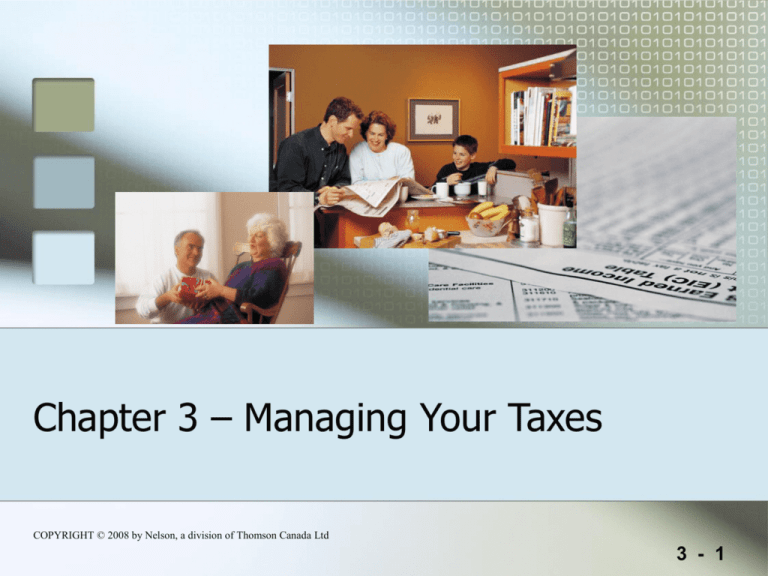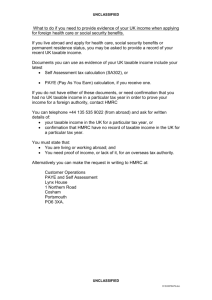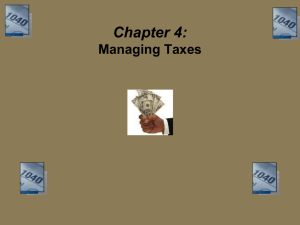Chapter 3 - Managing Your Taxes - Personal Financial Planning
advertisement

Chapter 3 – Managing Your Taxes COPYRIGHT © 2008 by Nelson, a division of Thomson Canada Ltd 3 - 1 Chapter 3 - Learning Goals LG 1 - Discuss the basic principles of income taxation. LG 2 - Describe the sources of income and deductions from income used to determine taxable income. LG 3 - Prepare a basic tax return using the appropriate forms and schedules. LG 4 - Explain when tax installments need to be made, when to file your return and how to amend your return. LG 5 - Know when to get help with your taxes and how software can streamline tax return preparation. LG 6 - Implement an effective tax planning strategy. Learning Goals 3 - 2 Chapter 3 – Managing Your Taxes Internet Links and On-Line Resources • • • • • • • • • • Planning tools Tax tips from accounting firm Grant Thornton Where your tax dollar goes. Government of Canada Determining the marginal tax rate on a particular source of income. Morningstar.ca Canada Revenue Agency Taxation of dividends received from Canadian Corporations. TD Economics General Income Tax and Benefit Package from CRA. Tax Forms and Schedules NETFILE Program Tax Preparation Services in your area certified by CRA to submit EFILE returns. Web Links 3 - 3 Chapter 3 – Managing Your Taxes Key Chapter Terms and Definitions Terms Canada Revenue Agency (CRA) Goods and Services Tax (GST) Harmonized Sales Tax (HST) Income Tax Act (ITA) Income taxes Progressive tax structure Marginal tax rate Average tax rate Withholding taxes Canada Pension Plan (CPP) Employment Insurance (EI) Total income Registered Retirement Savings Plan (RRSP) Registered Pension Plan (RPP) Tax deduction Tax credit T1 general return Surtax Notice of Assessment Tax Evasion Tax Avoidance 3 - 4 Chapter 3 – Managing Your Taxes Definitions Canada Revenue Agency (CRA) The Canada Revenue Agency (CRA) is the federal agency that is responsible for the administration of the tax laws for the Government of Canada and for most provinces and territories; and various social and economic benefit incentive programs delivered through the tax system. Terms 3 - 5 Chapter 3 – Managing Your Taxes Definitions Goods and Services Tax (GST) and Harmonized Sales Tax (HST) The goods and services tax (GST) is a federal sales tax that applies at a rate of 7% to the supply of goods and services in Canada. • It is a consumption tax. Harmonized sales tax (HST) is a sales tax that applies to the same base of goods and services as the GST, but a rate of 15%. Of this 7% is federal GST and 8% is a provincial sales tax. (HST has been adopted by some maritime provinces. In other provinces, the GST and a separate provincial sales tax PST is applied.) Terms 3 - 6 Chapter 3 – Managing Your Taxes Definitions Income Tax Act The Income Tax Act (ITA) is the federal statute that sets out the federal law on the taxation of income in Canada. • It was originally enacted in 1917 in Canada. Terms 3 - 7 Chapter 3 – Managing Your Taxes Definitions Income Taxes A type of tax levied on taxable income by the federal government and by provincial and territorial governments. Terms 3 - 8 Chapter 3 – Managing Your Taxes Definitions Progressive Tax Structure A tax system in which the greater the amount of taxable income, the higher the rate at which the marginal dollar of taxable income is taxed. Terms 3 - 9 Chapter 3 – Managing Your Taxes Definitions Marginal Tax Rate The tax rate you pay on an additional dollar of taxable income. Terms 3 - 10 Chapter 3 – Managing Your Taxes Definitions Average Tax Rate The rate at which each dollar of taxable income is taxed on average; calculated by dividing the taxes payable by taxable income. Terms 3 - 11 Chapter 3 – Managing Your Taxes Definitions Marginal versus Average Tax Rate A marginal tax rate is the rate you pay on an additional dollar of taxable income. FOR EXAMPLE: The marginal federal tax rate for a taxpayer with less than $30,000 of taxable income is 15.25% - for taxable income of over $118,286 is 29%. Terms An average tax rate is the rate at which each dollar of income is taxed at on average. It is calculated by dividing the taxes payable by the taxable income. NOTE: In a progressive tax system like Canada, the average rate of tax that a taxpayer faces is always less than the marginal rate. This is because the first few dollars of taxable income at taxed at the lowest rate, then once the limit is exceeded, additional dollars of taxable income at taxed a progressively higher rates. 3 - 12 Chapter 3 – Managing Your Taxes Definitions Withholding Taxes – Taxes Deducted at Source Taxes – based on the level of income and estimated taxes payable – that are deducted by an employer from the employee’s earnings each pay period and remitted to CRA. • Also known as taxes deducted at source. These at-source remittances include: • • • Federal and provincial income taxes Employee’s required contributions to the Canada Pension Plan (CPP) Employee’s required contributions to Employment Insurance (EI) Terms 3 - 13 Chapter 3 – Managing Your Taxes Definitions Canada Pension Plan The Canada Pension Plan is a federal government plan that provides retirement pensions, disability benefits and survivor benefits to individuals. Benefits are based on premiums paid into the plan. The plan covers both employed and self-employed individuals. Terms 3 - 14 Chapter 3 – Managing Your Taxes Definitions Employment Insurance Terms Employment Insurance is a federal program that provides temporary financial assistance for unemployed Canadian while they look for work or upgrade their skills. Canadians who are sick, pregnant or caring for a newborn or adopted child, as well as those who must care for a family member who is seriously ill with a significant risk of death, may also be assisted by Employment Insurance. 3 - 15 Chapter 3 – Managing Your Taxes Definitions Total income Income from all sources earned by a taxpayer during the year including income from employment, business, property and capital gains. Terms 3 - 16 Chapter 3 – Managing Your Taxes Definitions Registered versus Non-registered Investments A registered investment is one that has special tax treatment under the ITA. • Examples of registered investments include: o o o • Registered Pension Plans (RPP) Registered Retirement Savings Plan (RRSP), and Registered Retirement Income Fund (RRIF) These foregoing registered investments are specially registered with CRA and the amounts of money invested in them are not subject to tax, and additionally, the investment returns these investment returns earn over time are not subject to tax. These features increase the amount of money that tax payers can invest, given a limited disposable income, and increase the rate of return earned on the assets while protected from tax. Terms 3 - 17 Chapter 3 – Managing Your Taxes Definitions Registered versus Non-registered Investments … A non-registered investment is an investment in any asset that will produce investment returns (interest, dividends and capital gains) • Examples of non-registered investments include: • Terms Income-producing property Common stock Preferred stock Bonds Canada Savings bonds Savings Accounts Term Deposits Non-registered investment’s returns are subject to income tax in the year the returns are ‘realized.’ Chapter 3 – Managing Your Taxes 3 - 18 Definitions Realized Returns A realized return is one that is created at a point in time. • • • Terms In the case of interest, when it is accrued or when it is received in the form of cash, the interest income is ‘realized’ for tax purposes and therefore must be included in income and subject to tax in that calendar year. In the case of capital gains, when a financial asset such as a stock rises in price but is not sold to ‘capitalize’ on the price increase, the capital gain is not ‘realized’ for tax purposes. Such capital gains are NOT subject to tax. To realize a capital gain or capital loss, the investment must be sold (except in a deemed disposition situation). 3 - 19 Chapter 3 – Managing Your Taxes Definitions Registered retirement savings plan (RRSP) An individual retirement savings plan into which a taxpayer can make, within limits prescribed by CRA, tax-deductible contributions. Terms 3 - 20 Chapter 3 – Managing Your Taxes Definitions Registered pension plan (RPP) A pension plan offered by an employer into which an employee can make taxdeductible contributions based on the level of earnings of the individual. Terms 3 - 21 Chapter 3 – Managing Your Taxes Definitions Tax deduction Amounts that may be subtracted when calculating income. Deduction reduce taxable income by the amount of the deduction. Terms 3 - 22 Chapter 3 – Managing Your Taxes Definitions Tax credit Amounts that are deducted from a tax liability that reduce taxes otherwise payable. Terms 3 - 23 Chapter 3 – Managing Your Taxes Definitions T1 General Return The tax form used by most individuals when filing their annual income taxes. Terms 3 - 24 Chapter 3 – Managing Your Taxes Definitions Surtax An additional tax calculated based on a tax amount previously determined. Terms 3 - 25 Chapter 3 – Managing Your Taxes Definitions Notice of Assessment CRA’s acknowledgement of the filed return, summarizing the return, the balance owing (refund), the differences between CRA’s calculations and the filed return. • • Includes RRSP contribution room for the coming year. Includes statement of interest, penalties, and other information pertaining to outstanding balances. Terms 3 - 26 Chapter 3 – Managing Your Taxes Definitions Tax evasion The illegal act of failing to accurately report income or deductions, and, in extreme cases, failing to pay taxes altogether. Terms 3 - 27 Chapter 3 – Managing Your Taxes Definitions Tax avoidance The act of reducing taxes in ways that are legal and compatible with the intent of the ITA. Terms 3 - 28 Chapter 3 – Managing Your Taxes THE END! 3 - 29






